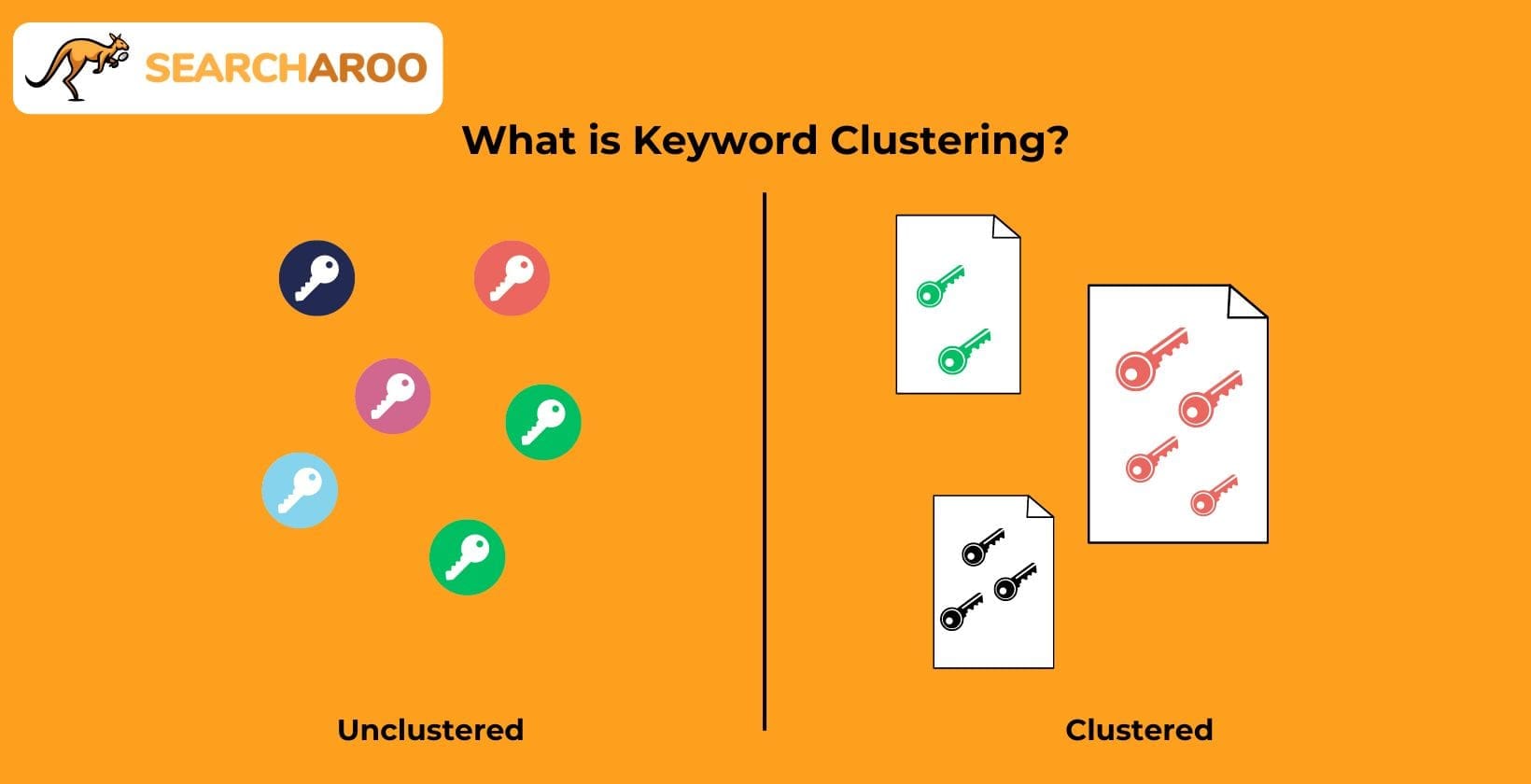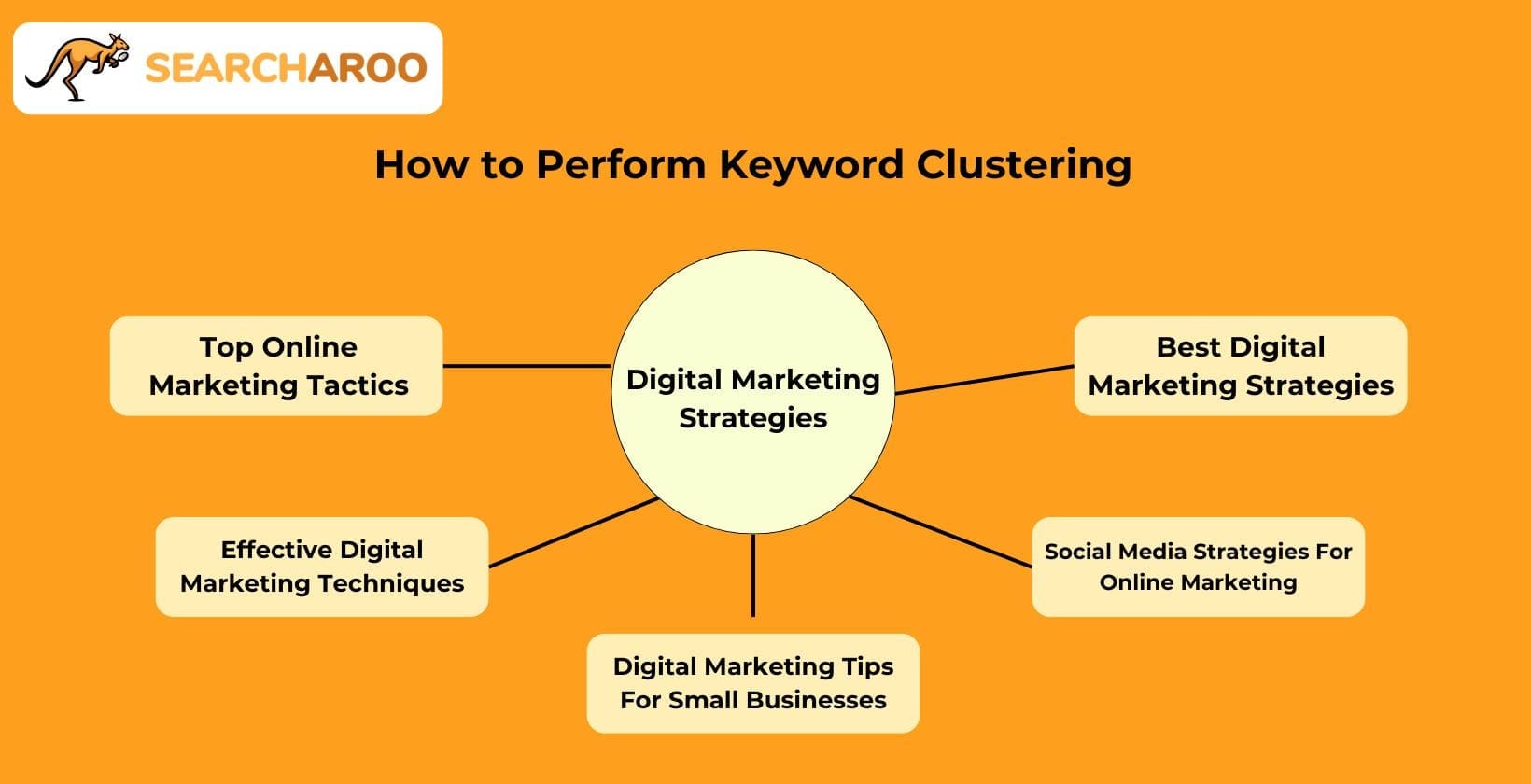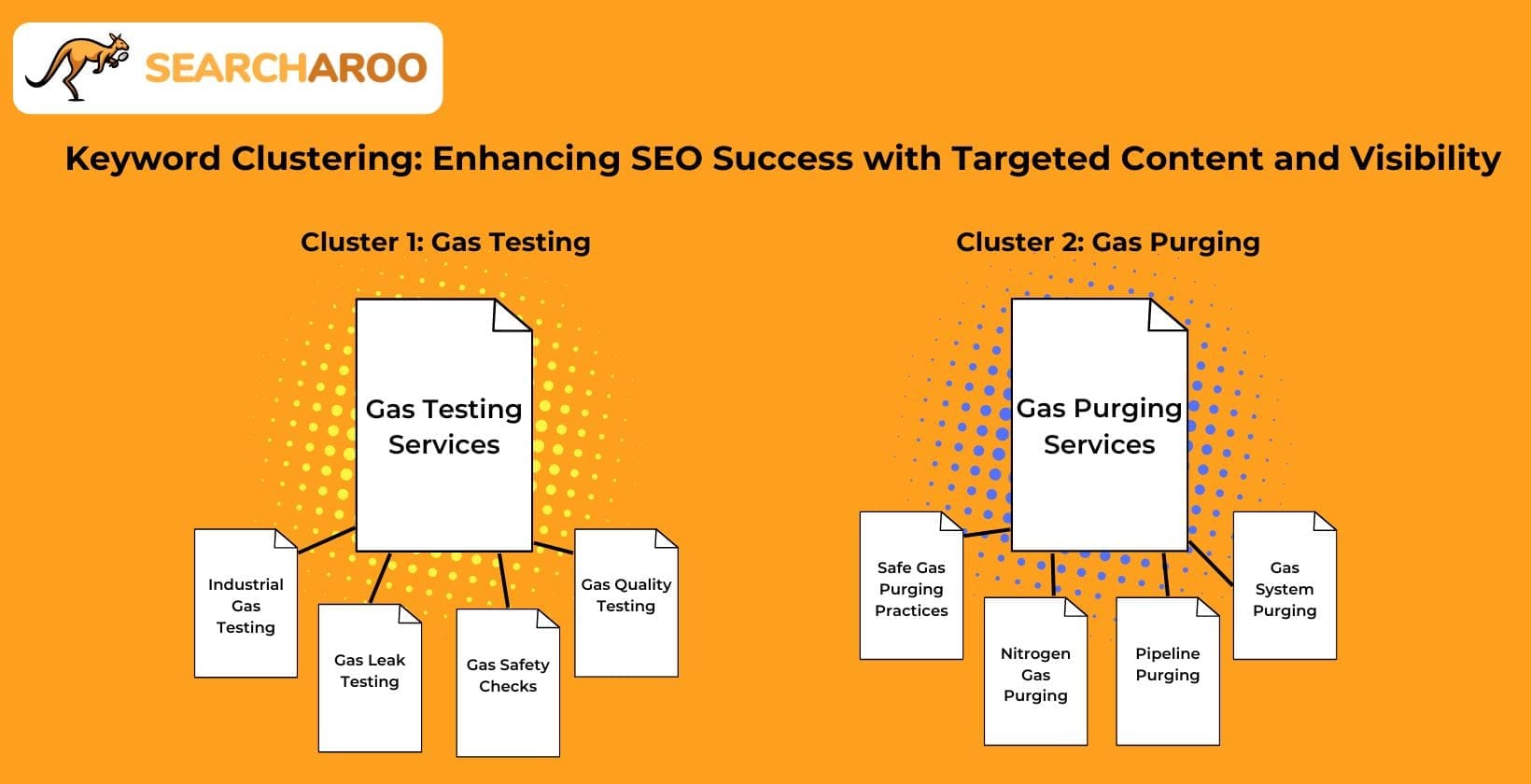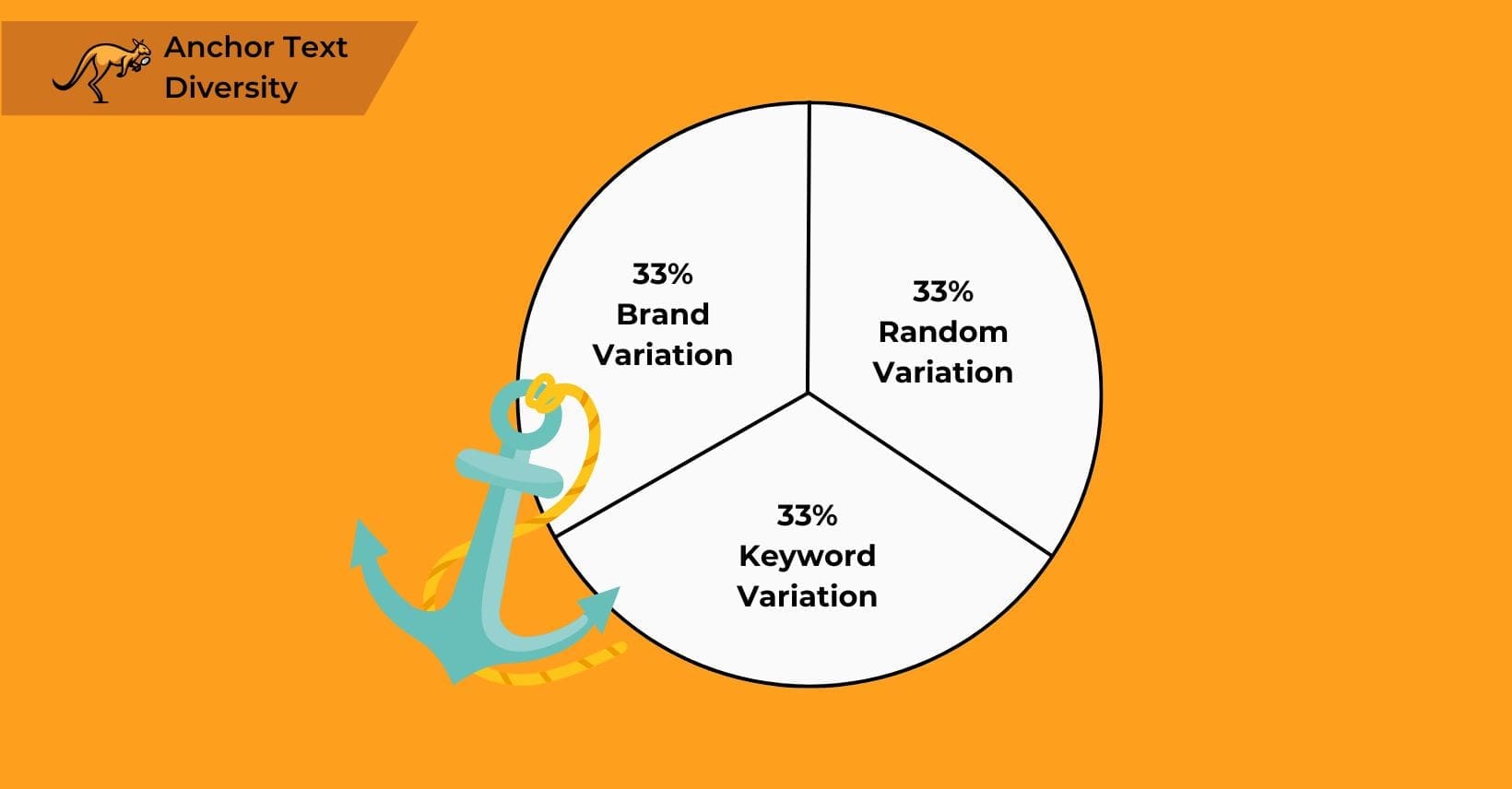Keywords play a crucial role in search engine optimization, making it essential to focus on them throughout any SEO project.
With thousands of relevant keywords available, finding the best one for each page or article can be challenging.
Keyword clustering offers a solution by grouping related keywords, enabling you to create keyword clusters that suit various content types in advance.
This approach simplifies the process, ensuring your content targets the right terms effectively.
Understanding how these clusters work can reveal their real potential in enhancing your SEO strategy.
What is Keyword Clustering?

What is Keyword Clustering?
Keyword clustering is the process of organizing keywords that share the same search intent and meaning into logical groups, which allows content creators to target multiple related terms with a single piece of content.
These clusters consist of closely related keywords, such as “red chair” and “red seat,” which convey the same idea differently.
Organizing keywords in this manner can better target your audience and improve your SEO strategy.
Keyword clustering significantly impacts SEO results by preventing keyword cannibalization, improving topical authority, and enabling more efficient content creation that targets multiple related search terms simultaneously.
Now, let’s explore the importance of this approach.
Why Does Keyword Clustering Matter?
Keyword clustering focuses on search intent, the reason behind users’ searches. Although many users share the same intent, they might phrase their searches differently.
This variety can be challenging if your audience uses many different phrases.
A keyword clustering strategy helps by targeting related keywords with the same search intent.
This allows you to address your audience’s entire group of keywords, using real keyword data to plan content.
But how can you effectively group these keywords to maximize your reach?
How Does Keyword Clustering Work?
Keyword clustering works by starting with seed keywords and expanding them into groups of semantically related terms, which prevents cannibalization and creates topical clusters that search engines recognize as comprehensive coverage of a subject.
Keyword cannibalization happens when you use the same keywords for multiple pieces of content or SEO efforts. Seed keywords are the short-tail keywords you start with.
Instead of focusing on one or two keywords, keyword clustering uses a seed keyword to find related keywords.
These keywords are then grouped and used as a pool of relevant keywords, each aiming at a similar audience.
This approach allows you to target the same audience differently without weakening your keyword choices through cannibalization. Now, let’s break it down into simpler terms.
In Simple Terms
Keyword clusters take a primary keyword and build a list of similar terms and phrases around it. These clusters target the same audience, allowing you to market effectively without repeating keywords.
Understanding how to perform keyword clustering is essential to refine your strategy and organize your content better.
How to Perform Keyword Clustering
Keyword clusters take a primary keyword and build a list of similar terms and phrases around it. These clusters target the same audience, allowing you to market effectively without repeating keywords.
By mastering this, you’ll be better prepared for the next crucial step in optimizing your content strategy.
Search For Keywords by Topic

Creating a keyword cluster based on a topic can be highly effective. It gives you a list of keywords targeting a niche, reaching a broader audience than a single keyword would.
Many keyword cluster tools let you generate keyword lists from a topic. They often provide search volume data and other key information, making building topic clusters from the best keywords simple.
Once you have your topic clusters, they become invaluable for digital marketing within a specific niche or audience.
Well-made clusters offer enough variety to capture a complete audience while staying focused on a larger topic to boost relevance.
To further refine your strategy, exploring how your competitors are performing is useful.
Look at Competitor Keywords
Many SEO professionals examine competitors’ keywords to expand their keyword clusters. Often, competitors target some of the same keywords as you, but their other keywords can also be valuable.
The right keyword research tools help you identify all the keywords your competitors target, providing you with a large batch of new keywords to review.
While not all keywords will be useful, especially those specific to a competitor’s business, this method is still effective for finding related keywords for a broader SEO strategy.
Knowing how to effectively leverage these keywords involves more than just identification; it’s also about understanding what users are searching for.
Understand Search Intent
Search intent forms the foundation of effective keyword clustering, as keywords must be grouped based on whether they share informational, navigational, commercial, or transactional intent, ensuring that each content piece precisely matches what users expect to find when using those search terms.
Variations in how users search exist within these intents and in general.
Familiarize yourself with how these groups search; some will use phrases like “buy (product)” more frequently, even if they’re all looking for similar pages.
By grasping these patterns, you can better align your content with users’ needs, paving the way for more informative approaches.
Informational
Informational search intent focuses on users wanting to learn. The goal could be to satisfy curiosity or to find important details, but it is to gain knowledge.
It’s not just about facts or figures; users may seek answers to specific questions, like how to solve a problem or find a niche product.
Informational searches thrive on clear, informative content with relevant keywords matching users’ queries.
Understanding this shows the importance of navigational searches, where users aim to find a specific website or page.
Navigational
Navigational searches are about finding a specific page or piece of content. These users aren’t looking to be convinced; they are trying to find a page or product they know exists.
Most searches use very specific terms, like exact product names or direct queries, implying that users know the product but not its name. These users focus more on finding their product or service than being shown others.
Navigational search intents can be tricky but broad, depending on users’ search. While one person might look for a specific product, another might search for a certain article using different keywords.
Now, let’s shift our focus to the commercial side of things.
Commercial
Commercial search intent is when a user wants to research something before buying. They are in the market for a product or service but need more information about a specific option or to feel confident in their choice.
For example, they might look up reviews or top-10 lists to find the “best X.” They know what kind of product they want but want more details to decide if each product is worth choosing over others.
These customers are still in the pre-purchase stage and aren’t ready to spend money. They are researching their options but may decide to pay for something if they feel reassured they’ve picked the right option.
Navigational search intents can be tricky to work with, but they can also be broad. It depends on what users are actually trying to search for—users looking for a particular product are similar to users looking for a certain article, but the keywords they use will be very different.
This brings us to the next crucial aspect of user intent: transactional.
Transactional
The transactional stage is where a user decides to complete a specific action. Despite the name, this doesn’t have to be a purchase, though many customers will want to buy something.
It could also include signing up for a free program, joining a site, or adding an item to their wishlist or cart for later.
They want to achieve a particular goal at this stage and will usually do so if nothing blocks their path.
These users are often the most determined to get what they want.
Targeting them focuses on helping them achieve their goal quickly or guiding them to the right place to buy what they seek.
Understanding user intent is crucial, but organizing your approach can make all the difference.
Clustering Your Keywords
To create keyword clusters, start by selecting a seed keyword and systematically build the cluster around it by adding semantically related terms, long-tail variations, and phrases that share the same search intent while maintaining topical relevance.
Usually, this means beginning with a short-tail keyword and adding long-tail keywords. For example, “bathroom furniture” can be expanded into terms such as “best bathroom furniture in the US.”
A good keyword clustering tool can help, but common sense is key.
Think about all the different ways a user might search for something, whether using plurals or shortening the phrase.
For instance, “best bathroom furniture in the US” could be “best bathroom furniture US,” “best US bathroom furniture,” or “best furniture for a bathroom US.” These are all similar but distinct.
Keywords are organized into meaningful clusters by analyzing semantic relationships, search intent alignment, SERP similarities, and topical relevance, then grouping terms that would logically belong on the same page or content piece to form cohesive topic clusters.
Once you’ve mastered this, understanding content keyword clustering brings your strategy even more clarity and efficiency.
Content Keyword Clustering
Keyword clusters are used for content like articles, blog posts, and website text that users and search engines see. In theory, keyword clustering is powerful if you keep content coming.
Providing content for each keyword in your clusters can help you dominate search rankings, but it doesn’t always work out that way.
Keyword clustering is pointless if the content is poor. Keyword grouping tools are effective, but you must create good content for those keywords.
Search engines love usefulness, relevance, and originality. Content that offers value to your audience will likely rank higher, appearing more often for the chosen keywords.
Of course, maintaining this strategy requires a steady flow of content, ensuring your site remains relevant and engaging.
Producing Regular Content
To create content effectively, focus on as many good keywords as possible. Producing distinct pieces for each keyword lets you target different audiences without overlapping terms or making common mistakes.
Start with the most versatile or valuable keywords from your list. A large keyword cluster can keep your content fresh for a long time, especially if you regularly update it steadily.
Each keyword should be the centre of unique content aimed at the audience that searches for it. This way, every piece is perfect for capturing a specific market segment.
Implementing this method will make organizing your keywords into clusters an essential part of refining your content strategy. This brings us to another important aspect of SEO planning that can further boost your results.
Using Keyword Clusters in Your SEO Content Strategy
Keyword clustering plays a central role in content strategy by providing a structured framework for content creation, allowing marketers to develop comprehensive topic coverage, plan content calendars around related terms, and build topical authority that search engines reward with higher rankings.
Clustering search terms improves SEO performance by enabling content to rank for multiple related keywords simultaneously, reducing content cannibalization, strengthening topical authority, and creating a more organized site structure that search engines can easily understand and index.
However, to use keyword clustering properly, you can’t just choose any word that shows up in search queries and create content around it.
It’s essential to know how keyword clustering should be used, and there’s more to consider, like the search volume and keyword difficulty.
Use Search Volume and Keyword Difficulty in Keyword Clustering Tools
Search volume measures how often each keyword in your cluster is searched for. Higher search volume indicates that the keyword is used frequently in searches, making it more valuable.
Generally, keywords with a higher search volume are more competitive. More users using a keyword regularly means ranking for that keyword puts your content in front of more potential customers.
However, don’t follow search volume blindly. Keyword difficulty, which measures how hard it is to rank for a keyword, is also important. Most high-search volume keywords are very competitive, so choosing a lower-search-volume keyword can sometimes be a better option. Targeting a high search volume keyword is pointless if you can’t rank for it.
Choose keywords that balance popularity and value without being too competitive. Many tools can provide these keyword insights, so check your keyword dataset before targeting the highest search volume keyword. To optimize your strategy, consider how relevance and related keywords can enhance your approach…
Focus on Relevance and Related Keywords
Not every keyword in your keyword list will be as relevant. Generic keywords may turn up in more search queries, but many of those may be irrelevant search queries.
You want to perform keyword research that gives you highly relevant keyword clustering opportunities.
Remember that not every keyword clustering tool differentiates these, either. Some tools simply suggest any keywords with semantic relationships with your seed keyword, whether or not they are relevant to your audience.
More modern keyword clustering tools use Natural Language Processing and other systems to simplify the fundamentals, but some manual oversight is still important.
You do not want to target a keyword that appears in hundreds of search engine results only to realize that those search engine results are for an entirely different niche that just so happens to use the same term in a different context.
Perform Proper Keyword Research
Good keyword research is crucial to keyword clustering. Your keyword clustering settings matter, but using tools like Google Search Console and Google Keyword Planner simplifies choosing good keywords from search results.
Whether optimizing content and internal links or seeking new marketing keywords, basic keyword research should never be skipped before creating SEO content.
Assumptions about keywords (e.g., thinking a keyword is “obviously” popular) can mislead you, as search results may differ.
Make keyword clustering data-driven. From Google Search Console internal linking details to keyword insights from organic search results, base your SEO strategy on hard facts.
Tools like Google Sheets help organize research and break down keyword insights.
Some businesses need to optimize pillar pages or internal linking, while others may require new SEO content. Even listing keywords, audience details, and matching URLs in Google Sheets can mean the difference between perfect SEO content and harming your search rankings.
In refining your approach, consider how SEO link-building agencies can help manage keyword clusters and improve overall strategy.
How SEO Link Building Agencies Help with Keyword Clustering?
SEO link-building agencies boost your website’s visibility and search engine ranking through strategic link-building.
These experts go beyond acquiring backlinks and helping with keyword clustering, a key process for organizing keywords into meaningful groups based on relevance and search intent.
With their understanding of SEO and advanced tools, link-building agencies identify keyword clusters that match your target audience’s search behaviour, making your content discoverable and relevant.
Keyword clustering groups related keywords to optimize content for broader search queries, enhancing SEO performance.
These agencies use sophisticated software and analysis techniques, examining search engine results pages (SERPs) to find common keyword patterns.
This approach helps create well-structured content that ranks for multiple related keywords, attracting organic traffic.
By integrating keyword clustering into link-building strategies, these agencies improve the quality and relevance of your content, driving targeted traffic to your site.
Choosing the right partner for your keyword clustering and link-building needs can make all the difference.
Why Choose Searcharoo for Keyword Clustering and Overall Link Building Needs?
When optimizing your website for search engines, choosing Searcharoo is a smart decision. Our expertise in keyword clustering enhances your content’s structure and relevance. By grouping related keywords based on search intent and SERP data, we help you create content that ranks higher and draws more targeted traffic. Our detailed insights and personalized strategies ensure your content is discoverable and highly relevant to your audience.
Our link-building services are also invaluable. We acquire high-quality backlinks to boost your site’s authority and visibility. Our team understands your niche and uses advanced SEO techniques to steadily increase organic traffic. With Searcharoo, you have a partner who delivers results to drive your business forward.
Understanding the importance of keyword clustering is key to your SEO strategy. We can boost your site’s performance and traffic by focusing on related keywords.
The importance of Keyword Clustering
Keyword clustering delivers numerous SEO benefits including improved topical authority, reduced content cannibalization, more efficient content planning, broader keyword targeting with fewer pages, and enhanced ability to match user search intent across various related queries.
Keyword clustering can be performed using specialized tools such as Google Keyword Planner, Ahrefs, SEMrush, and Keyword Insights, which analyze semantic relationships between terms, or through manual methods that leverage Google Search Console data to dramatically improve your overall SEO results.
However, like many SEO techniques, you can’t rush into it. You need to slow down and research the keywords that would work for the kind of cluster you want to make. For more insights on maximizing your SEO efforts, check out our article on link equity. See more on link equity.





